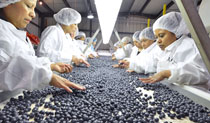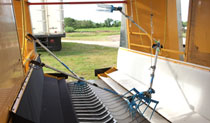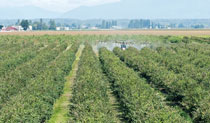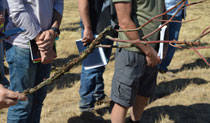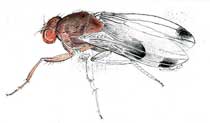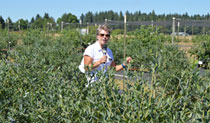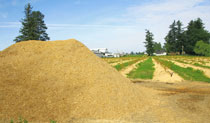Research in Mechanical Harvest for Fresh Showing Promise
A multi-state research project looking at mechanical harvesting for the fresh blueberry market is showing promise.
Using a suspended catch-system with hand-held shakers in an over-the-row system, workers in California were able in some cases to harvest as much as 800 pounds of blueberries per hour and get pack outs as high as 90 percent.
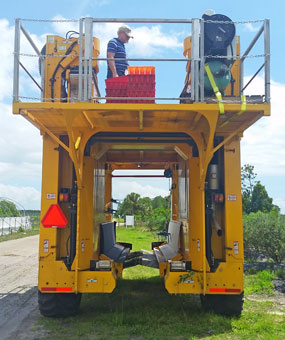 |
|
|
“It was good quality fruit,” said Fumiomi Takeda, a research horticulturist for the USDA Agricultural Research Service in Kearneysville, W.Va., who is leading the harvesting portion of the project, which is a USDA, NIFA (National Institute of Food and Agriculture) and Specialty Crop Research Initiative project awarded to Changying Li at the University of Georgia.
The 2017 research with semi-mechanical harvesting systems was conducted in Florida, California, Oregon and Washington. In the Pacific Northwest, the research was conducted at Pan American Berry Growers in Salem, and at a Maberry Packing Company field in Lynden, Washington, where researchers harvested Duke, Aurora, Liberty and Elliott varieties.
Oregon State University blueberry Extension agent Wei Yang and Lisa DeVetter, an assistant professor at Washington State University, are members of the team conducting the research.
The challenge, according to Takeda, has been to minimize bruising in mechanical harvesting to the point where berries can be stored and shipped to fresh markets around the world.
“With over the row machines we can harvest tons and tons of fruit each hour, but the drawback is that machine-harvest systems typically cause damage to fruit, so machine-harvested fruit cannot be stored for a long time,” Takeda said in a presentation at the 2018 Oregon Blueberry Conference, February 19 in Salem.
The trick, he said, comes down to modifying catch platforms to reduce internal bruising.
“We found that most of the fruit (when machine harvested with shaking rods) went straight down and determined that the catch plate causes the bulk of the damage to the fruit,” he said.
Using an instrumental sensor called BIRD for blueberry impact recording device, a device that measures impacts of individual blueberries during mechanical harvest, researchers measured the impact of blueberries hitting hard plastic catch plates and stainless steel surfaces.
“They all generally had relatively high impact,” Takeda said.
Researchers then looked at several modified surfaces to reduce that impact. “Using some of these surfaces in 2016 as harvest aid platforms in Michigan, Oregon and other locations, we got very good quality and we were pleased,” Takeda said.
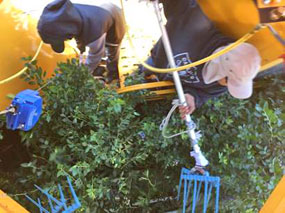 |
|
|
Researchers further revised the system in 2017. On an over-the-row (OTR) machine, rotary drum shakers were removed, platforms were installed so workers could stand and operate hand-held, air-powered shakers, hard plastic catch plates were removed and replaced with partially soft catch plates, and another catch surface was placed at an intermediate height to prevent blueberries from direct contact with the conveyor belt.
These changes in harvesting technologies resulted in a dramatic increase in the tonnage the workers were able to harvest per hour (while still maintaining fruit quality) compared to a pull-along “Easy Harvester” harvest-assist platform evaluated in 2016 in Hillsboro, Oregon, with workers handling the pneumatic shakers while walking beside the platform.
In later 2017, Oxbo installed rotary shakers back on the Model 7240, doing away with the hand-held shakers, while leaving in place the soft fruit catching surfaces. This system was able to harvest high quality fruit once again, Takeda said.
“The quality was very good,” Takeda said. “It was almost as good as hand harvested.”
In 2018, Oxbo International provided the research team with Oxbo 7440 and 8040 OTR harvesters that have been modified with soft fruit catching surfaces. One of both harvesters were tested at Norris Blueberry Farm and Tualatin Valley Blueberry Farms in Oregon and Olsen Brothers and Maberry Packing in Washington. In all of these tests, harvested berries were run through commercial packing lines with WECO soft and color sorters and with WECO color softer and MAF Industries optical sorter to obtain fresh pack out and defect (e.g. green, soft, overripe) data. On most harvest dates, as much as 92 percent of blueberries harvested by these two modified OTR harvesters were sorted as fresh market pack out, Takeda said.
Researchers have observed that some firm, but bruised, berries get packed in clamshells, he said. To sort bruised from non-bruised blueberries among blueberries categorized as fresh pack out, Changying Li, the UG scientist, developed a non-destructive technique of locating and measuring bruise damage by scanning blueberries with light in the near infrared range. The technology, called hyperspectral imaging, has identified the light wavelengths that aid in distinguishing non-bruised and bruised blueberries, Takeda said. At certain wavelengths the spectral signature from non-bruised and bruised tissues is different.
Takeda plans to continue working with the harvest equipment manufacturer Oxbo International to further refine the system in 2019 and beyond, particularly looking at the catch plate design, he said. Yang and DeVetter plan to continue the harvesting project in the Pacific Northwest with funding from Oregon and Washington administered Specialty Crop Block Grant programs.
“The goal is to deliver high quality blueberries to consumers through using an improved OTR (over-the-row) mechanical harvesting system and berry sorting technology,” Takeda said. “What we want is a fruit that looks like it has been hand harvested and its inside shows no damage. Eventually, there will be a harvesting system for blueberries that can be held in storage for four weeks and reach distant Pacific Rim markets with high quality.”
| FALL 2018
|
